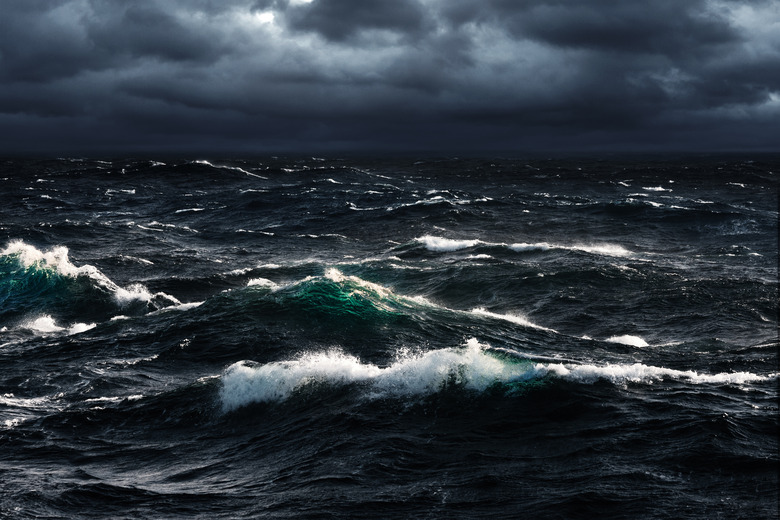What Are Deep Currents?
The many massive layers of water beneath the wavy surface of an ocean are considered deep ocean layers, and an estimated 90 percent of an ocean is deep water. Different forces combine to cause that water to generate deep ocean currents that flow around the globe with a specific circulation pattern.
Deep Ocean Currents
Deep Ocean Currents
Deep ocean currents in oceans are caused by a large amount of sinking surface water. Surface water is the upper layer of water closest to the top surface. The sun can easily reach this top layer, heat up the surface water and evaporate some of the water. When the surface water becomes extremely cold, the lower temperature and the additional salt causes the surface water to become more dense than the water beneath it, and thus the surface water sinks down to the deep water layers of the ocean in a circulation process known as thermohaline circulation. Thermohaline circulation, or the sinking of highly dense surface water, is the source of deep currents in oceans.
Where They Occur
Where They Occur
Thermohaline circulation can only develop in extremely cold regions where the temperature of the air is low enough to make the surface water very cold, highly salty and more dense than the water beneath it. Thus, deep currents generally occur in the higher latitude regions of the Earth, such as North Atlantic Deep Water and Antarctic Bottom Water, and from these frigid poleward regions the deep currents flow at a relatively slow pace towards the equator.
Characteristics
Characteristics
After the thermohaline circulation process, the surface water that sinks down to the deep ocean does not mix well with the water beneath it, and thus it is easy to identify the sinking water masses using scientific data. Deep currents can be distinguished by the extremely cold water temperatures, the relatively high concentration of oxygen and the high salt levels that all result from sinking surface water. Because of these conditions, the water in deep ocean currents is also very dense.
Circulation Pattern
Circulation Pattern
Many deep currents follow a specific circulation pattern as they travel around the planet, and the pattern usually forms a cycle. Most sinking deep water currents form in the North Atlantic, near Iceland, and from there the deep current begins its circulation pattern. The highly dense water in the deep current flows southward passed the southern edge of Africa, travels across the southern Indian Ocean, flows passed the east side of Australia, and merges into the North Pacific. Once the deep current enters the North Pacific, increasing temperatures cause a lower density in the deep water, and in turn the water becomes more buoyant and rises up to the surface again.
The surface water in the North Pacific then flows south, sliding between Asia and Australia, wraps around the southern edge of Africa again–but this time moving west–and then flows across the South Atlantic. From the South Atlantic, the water connects with the Gulf Stream and flows up north again. Once it returns to the colder, higher latitudes of the North Atlantic, the dense surface water sinks back down to the lower deep water, forms a deep current and repeats the entire cycle again.
Cite This Article
MLA
Heuberger, Brian. "What Are Deep Currents?" sciencing.com, https://www.sciencing.com/deep-currents-8118821/. 22 November 2019.
APA
Heuberger, Brian. (2019, November 22). What Are Deep Currents?. sciencing.com. Retrieved from https://www.sciencing.com/deep-currents-8118821/
Chicago
Heuberger, Brian. What Are Deep Currents? last modified March 24, 2022. https://www.sciencing.com/deep-currents-8118821/
